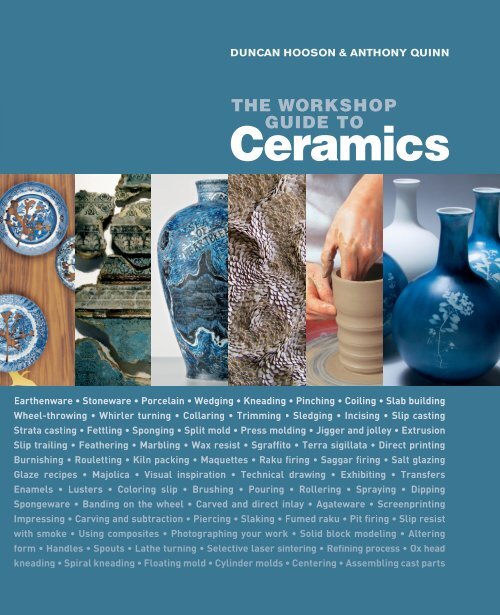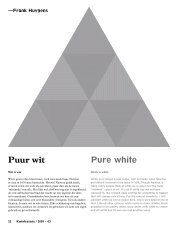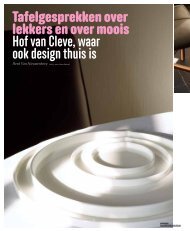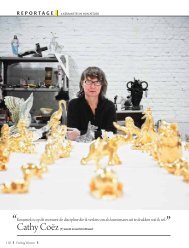Ceramics - Ann Van Hoey
Ceramics - Ann Van Hoey
Ceramics - Ann Van Hoey
Create successful ePaper yourself
Turn your PDF publications into a flip-book with our unique Google optimized e-Paper software.
68 Forming TechniquesHand Building: Slab Building 69tNavigatorMaterials, Tools and Process(pages 20–51)Forming Techniques(pages 52–169)• Hand BuildingPinchingCoiling• Slab BuildingSolid Block Modelling• Throwing• Model Making• Mould Making• Tile Making• Extrusion• CAD/CAMPrefiring Surface Decoration(pages 170–217)Firing (pages 218–243)Glazing (pages 244–261)Post-glaze Surface Decoration(pages 262–283)Design (pages 284–295)Professional Practice(pages 296–307)There are two main methods of slab building, which are dependent on the conditionof the clay before forming. The sheets of clay may be either fresh and soft (soft slabs)or partially dry (leather-hard slabs). Soft slabs will allow you to manipulate and alterthem by bending, folding, pressing and stretching as you build. Hard slabs allow youto construct complex, angular, sharp-edged forms as though using sheets of wood.HAND BUILDING: Slab buildingSlabs are used to create a variety of forms for bothfunction and sculpture. You can make exquisitesmall boxes that are beautifully carved; simplecylindrical tubes; create monumental-scale formsthat stand tall, or tiles that cover vast areas ofwalls and roofs. All of these are open to thepossibility of varying textural surface qualities.Leather-hard slabsSlab building using leather-hard slabs is one ofthe few techniques that enables you to designand make your form completely in card beforeyou touch the clay. You can then use thesecard templates in the same way a pattern cutterwould, to cut out the individual elements beforeassembly. This gives you the opportunity to see,assess and make adjustments to the final formbefore spending any time making. It will alsoenable you to decide the type of clay best suitedto the scale of work you wish to make.Soft slabsSoft slabs are used either to create undulatingforms or in conjunction with a range of semihardor hard supporting objects and materials tocreate a wide variety of forms for both functionand sculpture. Smooth, fine clay can be foldedand pleated almost like cloth. If you do this,make sure you have not trapped air in sealedpockets. You can always push a pin into areasRi b b e d s c u l p t u r e sb y Fe n e l l a El m sThis pair of skeletal slabforms demonstrates theextraordinary flexibilityof working with softsheets of clay. The makingand drying of forms canbe assisted by resting ontheir sides on foam andinsulating paper fibres.Sl a b-b u i lt s c u l p t u r eb y Pe t r a Wo l fWhen working with slabs youcan explore balance and tension.This sculpture emphasizes thestress of where its weight hasproduced surface cracks duringthe making process.you are not sure about to release air and keepthe form from bursting during firing. Surfacedecoration and texture may be left until the formis completed or can be an integral part of themaking of the slab.Appropriate claysThe use of paper clay has changed some ofthe rules regarding slab working, because youcan dry these slabs of clay and then assemblethem with slurry. This has eliminated many ofthe drying, cracking and wrapping problemsinherent in the use of other clays.Other additives to clay have been used formany years – think of building walls with wattleand daub. Makers have more recently used nylonfibres, fibreglass, cloth and sawdust to build verylarge slabbed forms. This means the clay shrinksand warps less and helps with bonding the clayparticles during the drying process.Architectural clay bodies are available from claysuppliers. These clays have been blended withvery high contents of grog and have minimalshrinkage between making and finishing. Crankand raku clay bodies are similar in blend, feeland texture, creating what’s known as an ‘openbody’. Take care when using these clays; the moretextured the clay body, the more the clay willstart to open out and crack as you manipulateit. This characteristic is often used to highlightand create textured cracked surfaces. Thesebodies have very good mechanical greenwarestrength (bone-dry stage) and are ideal formedium- to large-scale working. Fine clays likeporcelain offer the maker different challenges,but in time you’ll be able to use them just assuccessfully, and they offer their own qualities,such as translucency. The more you use a type ofclay, the more you will learn about its particularhandling characteristics.Fo l d e d sl a b sb y An n va n Ho e yThese finely made slab formshave been cut and folded likepaper while being supportedduring the making and dryingperiod in plaster moulds.





